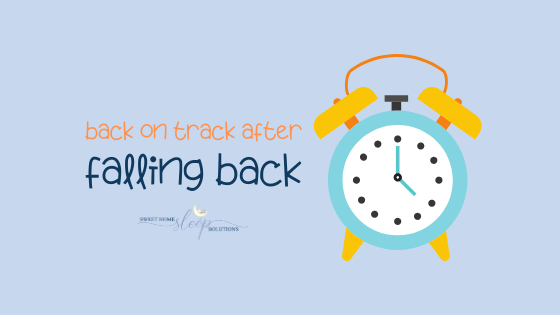Back on Track: Fall Time Change
Years ago, I LOVED Daylight Saving. I was in college, so it meant a much welcomed extra hour of sleep!
Now, as a parent and consultant I still highly value sleep, but the reality is that our babies don’t exactly appreciate that extra hour.
Unfortunately, however wonderful that sleep may sound, disrupting natural sleep cycles can have negative impacts on our health. Our diets, moods, productivity, and overall health can be compromised. Time changes are hard on adults and definitely hard on little ones who don’t understand what’s happening.
This year, Daylight Saving ends on November 3rd and if you have little ones at home, they’ll be waking one hour early according to the new time. So, a baby that normally wakes at 6AM. will be bright eyed and bushy tailed at 5AM. Sounds like fun!
So, what’s the best way to handle it and can we make the transition smoother? YES!
Tip #1: Wait until AFTER you wake on Sunday.
Why? Seeing that earlier time just stinks! When you think you’re waking an hour earlier, it can lead to a negative start to your day. If you wake at your normal time, have some coffee, then realize you have an extra hour in your day, it’s not so bad.
Tip #2: Split the difference with the old and new time.
Essentially, take the time change slowly in your house. It can take our bodies a week or two to truly adjust. So based on the age of your children, follow the suggestion below that matches your kid(s) age:
School Age Children
For an older child who does not nap, you would put them to bed half an hour earlier than normal. This means If bedtime is 7:30PM, they’ll go to bed at 7:00PM on Sunday night.
After three nights have passed, you will move bedtime back to the original time. Your child will now be back to the normal 7:30 bedtime by Wednesday night!
Toddlers
If you have a toddler or child on one nap, you will put them down for their nap 30 minutes earlier than normal. So, if nap is normally at 12:00PM, you would put them down at 11:30PM for three days starting on Sunday.
The same is true for bedtime. If bedtime is normally 7:00PM, you will put them to bed at 6:30PM for three days. By Wednesday, naps and bedtime will be back to normal at 12:00PM and 7:00PM, or whatever your normal routine times may be.
Baby
If your baby’s naps and bedtimes are more predictable and established (normally around 7 months), you will move bedtimes and naps in 15 minute increments. If your child naps at 9:00AM, Day 1 naptime (Sunday) would be at 8:15AM, Day 2 would be at 8:30AM, Day 3 would be at 8:45AM, and Day 4 would be back to 9:00AM.
Bedtimes would change in the same way. A normal bedtime of 7:00PM would change to 6:15PM, 6:30PM, 6:45PM and then back to 7:00PM on Day 4.
If your child wakes early, do not rush in as soon as you hear them waking up. Help your child’s body understand that it isn’t morning yet by keeping him in his crib in the dark room until the normal wake time.
If naps and bedtimes are NOT predictable (0-6 months old), go ahead and adjust immediately. Use appropriate awake times as your guide for nap and nights.
Note for Toddlers/School-Aged Children
If your child relies on a clock to know when morning has arrived, set the clock a half hour ahead of the new time. It will then read 7:00AM instead of 6:30AM. They will be waking earlier than normal, but your child will adjust with time (generally around a week or two).
Most children adjust within the first week; however, it is not abnormal for some to take up to a month. Being as consistent as possible with bedtimes and naps helps.
Is your little one having trouble sleeping and it has nothing to do with the time change?
I’ve been there before and I’d love to help change that!
Book a FREE 15-minute consultation with me today.

